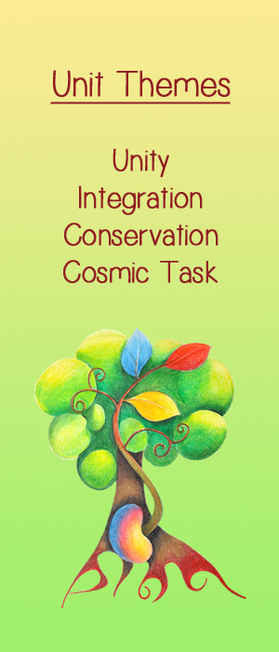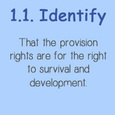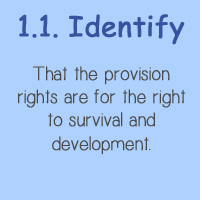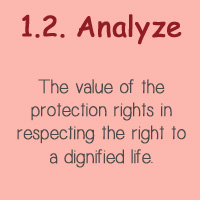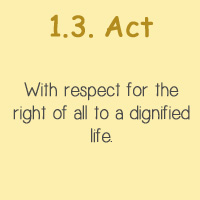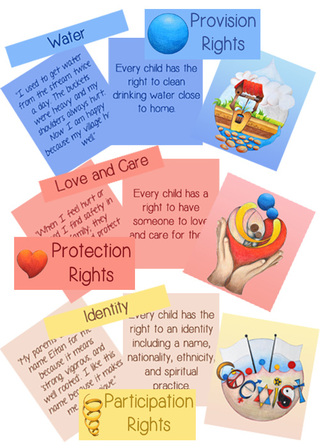Classroom Learning Activities
1. Provision Rights
Use this material to review and expand on the Convention's Provision Rights including: Water, Food, Home, Health, Education and Play. This material is available for purchase here.
Use this material to review and expand on the Convention's Provision Rights including: Water, Food, Home, Health, Education and Play. This material is available for purchase here.
|
Material Includes:
Presentation Method:
|
Relevant Convention Articles
Article 1
For the purposes of the present Convention, a child means every human being below the age of eighteen years unless under the law applicable to the child, majority is attained earlier.
Article 6
1. States Parties recognize that every child has the inherent right to life.
2. States Parties shall ensure to the maximum extent possible the survival and development of the child.
Article 24
1. States Parties recognize the right of the child to the enjoyment of the highest attainable standard of health and to facilities for the treatment of illness and rehabilitation of health. States Parties shall strive to ensure that no child is deprived of his or her right of access to such health care services.
2. States Parties shall pursue full implementation of this right and, in particular, shall take appropriate measures:
(a) To diminish infant and child mortality;
(b) To ensure the provision of necessary medical assistance and health care to all children with emphasis on the development of primary health care;
(c) To combat disease and malnutrition, including within the framework of primary health care, through, inter alia, the application of readily available technology and through the provision of adequate nutritious foods and clean drinking-water, taking into consideration the dangers and risks of environmental pollution;
(d) To ensure appropriate pre-natal and post-natal health care for mothers;
(e) To ensure that all segments of society, in particular parents and children, are informed, have access to education and are supported in the use of basic knowledge of child health and nutrition, the advantages of breastfeeding, hygiene and environmental sanitation and the prevention of accidents;
(f) To develop preventive health care, guidance for parents and family planning education and services.
3. States Parties shall take all effective and appropriate measures with a view to abolishing traditional practices prejudicial to the health of children.
4. States Parties undertake to promote and encourage international co-operation with a view to achieving progressively the full realization of the right recognized in the present article. In this regard, particular account shall be taken of the needs of developing countries.
Article 27
1. States Parties recognize the right of every child to a standard of living adequate for the child's physical, mental, spiritual, moral and social development.
2. The parent(s) or others responsible for the child have the primary responsibility to secure, within their abilities and financial capacities, the conditions of living necessary for the child's development.
3. States Parties, in accordance with national conditions and within their means, shall take appropriate measures to assist parents and others responsible for the child to implement this right and shall in case of need provide material assistance and support programmes, particularly with regard to nutrition, clothing and housing.
4. States Parties shall take all appropriate measures to secure the recovery of maintenance for the child from the parents or other persons having financial responsibility for the child, both within the State Party and from abroad. In particular, where the person having financial responsibility for the child lives in a State different from that of the child, States Parties shall promote the accession to international agreements or the conclusion of such agreements, as well as the making of other appropriate arrangements.
Article 28
1. States Parties recognize the right of the child to education, and with a view to achieving this right progressively and on the basis of equal opportunity, they shall, in particular:
(a) Make primary education compulsory and available free to all;
(b) Encourage the development of different forms of secondary education, including general and vocational education, make them available and accessible to every child, and take appropriate measures such as the introduction of free education and offering financial assistance in case of need;
(c) Make higher education accessible to all on the basis of capacity by every appropriate means;
(d) Make educational and vocational information and guidance available and accessible to all children;
(e) Take measures to encourage regular attendance at schools and the reduction of drop-out rates.
2. States Parties shall take all appropriate measures to ensure that school discipline is administered in a manner consistent with the child's human dignity and in conformity with the present Convention.
3. States Parties shall promote and encourage international cooperation in matters relating to education, in particular with a view to contributing to the elimination of ignorance and illiteracy throughout the world and facilitating access to scientific and technical knowledge and modern teaching methods. In this regard, particular account shall be taken of the needs of developing countries.
For the purposes of the present Convention, a child means every human being below the age of eighteen years unless under the law applicable to the child, majority is attained earlier.
Article 6
1. States Parties recognize that every child has the inherent right to life.
2. States Parties shall ensure to the maximum extent possible the survival and development of the child.
Article 24
1. States Parties recognize the right of the child to the enjoyment of the highest attainable standard of health and to facilities for the treatment of illness and rehabilitation of health. States Parties shall strive to ensure that no child is deprived of his or her right of access to such health care services.
2. States Parties shall pursue full implementation of this right and, in particular, shall take appropriate measures:
(a) To diminish infant and child mortality;
(b) To ensure the provision of necessary medical assistance and health care to all children with emphasis on the development of primary health care;
(c) To combat disease and malnutrition, including within the framework of primary health care, through, inter alia, the application of readily available technology and through the provision of adequate nutritious foods and clean drinking-water, taking into consideration the dangers and risks of environmental pollution;
(d) To ensure appropriate pre-natal and post-natal health care for mothers;
(e) To ensure that all segments of society, in particular parents and children, are informed, have access to education and are supported in the use of basic knowledge of child health and nutrition, the advantages of breastfeeding, hygiene and environmental sanitation and the prevention of accidents;
(f) To develop preventive health care, guidance for parents and family planning education and services.
3. States Parties shall take all effective and appropriate measures with a view to abolishing traditional practices prejudicial to the health of children.
4. States Parties undertake to promote and encourage international co-operation with a view to achieving progressively the full realization of the right recognized in the present article. In this regard, particular account shall be taken of the needs of developing countries.
Article 27
1. States Parties recognize the right of every child to a standard of living adequate for the child's physical, mental, spiritual, moral and social development.
2. The parent(s) or others responsible for the child have the primary responsibility to secure, within their abilities and financial capacities, the conditions of living necessary for the child's development.
3. States Parties, in accordance with national conditions and within their means, shall take appropriate measures to assist parents and others responsible for the child to implement this right and shall in case of need provide material assistance and support programmes, particularly with regard to nutrition, clothing and housing.
4. States Parties shall take all appropriate measures to secure the recovery of maintenance for the child from the parents or other persons having financial responsibility for the child, both within the State Party and from abroad. In particular, where the person having financial responsibility for the child lives in a State different from that of the child, States Parties shall promote the accession to international agreements or the conclusion of such agreements, as well as the making of other appropriate arrangements.
Article 28
1. States Parties recognize the right of the child to education, and with a view to achieving this right progressively and on the basis of equal opportunity, they shall, in particular:
(a) Make primary education compulsory and available free to all;
(b) Encourage the development of different forms of secondary education, including general and vocational education, make them available and accessible to every child, and take appropriate measures such as the introduction of free education and offering financial assistance in case of need;
(c) Make higher education accessible to all on the basis of capacity by every appropriate means;
(d) Make educational and vocational information and guidance available and accessible to all children;
(e) Take measures to encourage regular attendance at schools and the reduction of drop-out rates.
2. States Parties shall take all appropriate measures to ensure that school discipline is administered in a manner consistent with the child's human dignity and in conformity with the present Convention.
3. States Parties shall promote and encourage international cooperation in matters relating to education, in particular with a view to contributing to the elimination of ignorance and illiteracy throughout the world and facilitating access to scientific and technical knowledge and modern teaching methods. In this regard, particular account shall be taken of the needs of developing countries.
Online Resources and References
- American Montessori Society (2002). Montessori Elementary I Different: What Children Study, What Children Do. Also see Montessori Terminology.
- Duffy, D Neil, and Duffy, Michael (2002). Children of the Universe: Cosmic Education in the Montessori Elementary Classroom. Hollidaysburg, PA: Parent Child Press.
- Education International - Peace Education.
- Education Revolution - The Montessori Educational Vision.
- Humanium Help the Children - Right to Life: Understanding children's right to life.
- Ireland Department of Health and Children - The Agenda for Children's Services: A Policy Handbook.
- Miller, John P. and Yoshiharu Nakagawa. (2002). Nourishing the Spiritual Embryo: The Educational Vision of Maria Montessori. Nurturing Our Wholeness: Perspectives on Spirituality in Education. Retrieved from http://www.pathsoflearning.net/articles_Montessori.php.
- Montessori, Mario M. Jr. (1976). Education for Human Development: Understanding Montessori. New York: Schocken Books, NY.
- North American Montessori Center - Montessori Teacher Training: The Purpose of Montessori Cosmic Education.
- Stern, Rebecca. (2006). The Child's Right to Participation - Reality or Rhetoric? Department of Law, Uppsala University, Sweden. Retrieved from http://uu.diva-portal.org/smash/get/diva2:168647/FULLTEXT01.
- UNICEF - The Convention on the Rights of the Child: Survival and developmental rights: the basic rights to life, survival and development of one's full potential.
